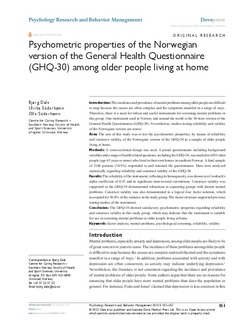| dc.contributor.author | Dale, Bjørg | |
| dc.contributor.author | Söderhamn, Ulrika | |
| dc.contributor.author | Söderhamn, Olle | |
| dc.date.accessioned | 2012-12-12T12:00:40Z | |
| dc.date.available | 2012-12-12T12:00:40Z | |
| dc.date.issued | 2012 | |
| dc.identifier.citation | Dale, B., Söderhamn, U., & Söderhamn, O. (2012). Psychometric properties of the Norwegian version of the General Health Questionnaire (GHQ-30) among older people living at home. Psychology Research and Behavior Management(5), 151-157. doi: 10.2147/PRBM.S37502 | no_NO |
| dc.identifier.issn | 1179-1578 | |
| dc.identifier.uri | http://hdl.handle.net/11250/139021 | |
| dc.description | Published version of an article from the journal:Psychology Research and Behavior Management. Also available from Dove press: http://dx.doi.org/10.2147/PRBM.S37502 | no_NO |
| dc.description.abstract | Introduction: The incidence and prevalence of mental problems among older people are difficult to map because the causes are often complex and the symptoms manifest in a range of ways. Therefore, there is a need for robust and useful instruments for screening mental problems in this group. One instrument used in Norway and around the world is the 30-item version of the General Health Questionnaire (GHQ-30). Nevertheless, studies testing reliability and validity of the Norwegian version are scarce.
Aim: The aim of this study was to test the psychometric properties, by means of reliability and construct validity, of the Norwegian version of the GHQ-30 in a sample of older people living at home.
Methods: A cross-sectional design was used. A postal questionnaire including background variables and a range of health related questions, including the GHQ-30, was mailed to 6033 older people (age 65 years or more) who lived in their own homes in southern Norway. A final sample of 2106 persons (34.9%) responded to and returned the questionnaire. Data were analyzed statistically regarding reliability and construct validity of the GHQ-30.
Results: The reliability of the instrument, reflecting its homogeneity, was shown in a Cronbach’s alpha coefficient of 0.93 and in significant item-to-total correlations. Construct validity was supported as the GHQ-30 demonstrated robustness in separating groups with known mental problems. Construct validity was also demonstrated in a logical four factor solution, which accounted for 50.0% of the variance in the study group. The factor structure supported previous testing studies of the instrument.
Conclusion: The GHQ-30 showed satisfactory psychometric properties regarding reliability and construct validity in this study group, which may indicate that the instrument is suitable for use in screening mental problems in older people living at home. | no_NO |
| dc.language.iso | eng | no_NO |
| dc.publisher | Dove Press | no_NO |
| dc.title | Psychometric properties of the Norwegian version of the General Health Questionnaire (GHQ-30) among older people living at home | no_NO |
| dc.type | Journal article | no_NO |
| dc.type | Peer reviewed | no_NO |
| dc.subject.nsi | VDP::Medical disciplines: 700::Clinical medical disciplines: 750::Psychiatry, child psychiatry: 757 | no_NO |
| dc.subject.nsi | VDP::Medical disciplines: 700::Clinical medical disciplines: 750::Geriatrics: 778 | no_NO |
| dc.source.pagenumber | 151-157 | no_NO |
| dc.source.journal | Psychology Research and Behavior Management | no_NO |
| dc.source.issue | 5 | no_NO |
